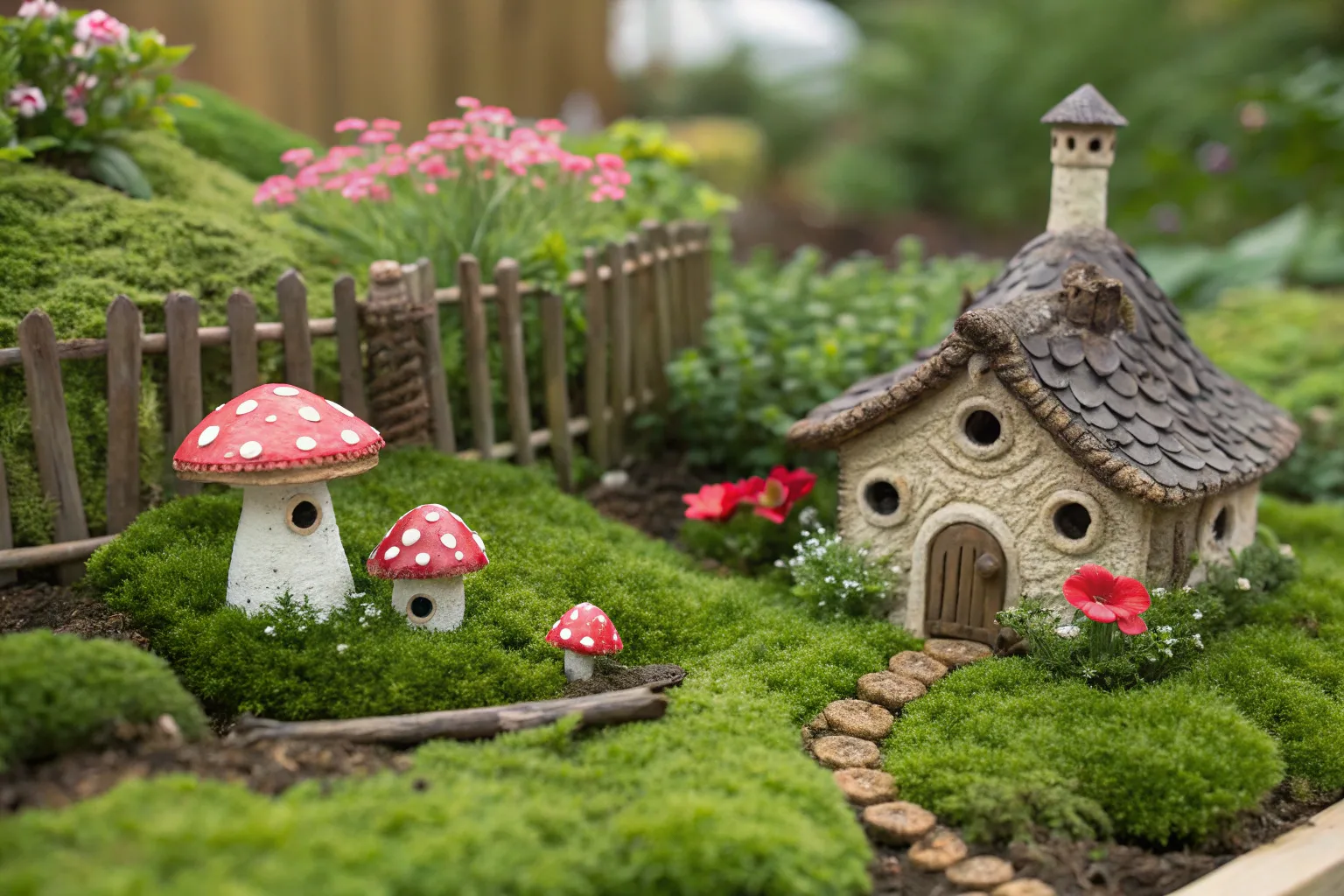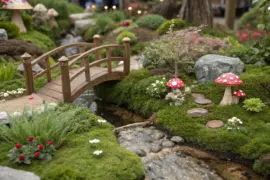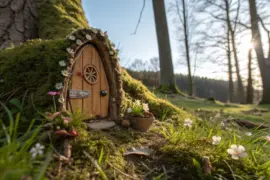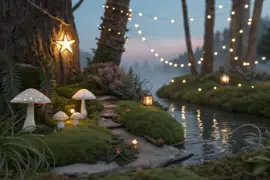Step into a miniature world where toadstools shelter sleeping sprites and acorn caps become the tiniest of teacups.
Building the Foundation of Wonder

Creating fairy worlds begins with choosing the right stage for your miniature magic. A shallow terracotta pot provides an ideal canvas for beginners—its rustic surface adds instant charm, while the drainage hole helps if you want to add living plants. For indoor displays, repurpose glass jars, old drawers, or even cake stands to become enchanted habitats. The container you select shapes the entire story: a weathered wooden box suggests an ancient forest hideaway, while a glass cloche creates a snow-globe quality that magnifies every detail.
The foundation matters more than you might think. Start with a base layer that supports both structure and imagination. For outdoor gardens, potting soil mixed with small stones creates natural drainage and realistic terrain. Indoor scenes work beautifully with a combination of air-dry clay for sculpted hills and preserved moss for soft, verdant carpeting. Some crafters create elevated levels using broken pottery pieces or river rocks, transforming flat surfaces into multi-dimensional landscapes where fairies can climb, explore, and discover.
Creating Pathways and Places:
- Smooth pebbles arranged in winding patterns become ancient stone walkways
- Aquarium gravel in blue tones transforms into shimmering streams
- Bark pieces cut into thin slices make rustic stepping stones
- Small twigs bound with twine create simple bridges
Crafting Homes for the Smallest Residents

The heart of any fairy world lives in its dwellings—those impossibly charming houses that make you wish you could shrink down and step inside. For beginners, polymer clay offers the perfect medium: it’s forgiving while you work, holds fine details beautifully, and bakes to permanent hardness in a standard home oven.
Simple Mushroom House (Beginner Project):
Begin with a glass jar turned upside down—this becomes both structure and light source. Cover the jar with a thin layer of polymer clay in earthy browns or mossy greens, pressing firmly to eliminate air bubbles. Use a textured tool (even a toothbrush works) to create bark-like patterns in the clay. Cut out small windows with circular cutters, imagining fairy faces peeking through as twilight falls.
For the iconic mushroom cap roof, shape aluminum foil into a dome and cover it with bright red or speckled polymer clay. A spoon works beautifully to smooth the surface into an even, organic shape. Add white dots for that classic toadstool appearance. Bake according to clay package directions—usually around 15-20 minutes for small sections.
Natural materials bring authentic woodland character to fairy architecture. Flat pieces of birch bark become walls for treehouse-style dwellings when glued to cardboard forms. Gather shed bark (never peel from living trees) during nature walks, selecting pieces with interesting textures and natural curves. Hot glue provides strong bonds, though younger crafters should work with adult supervision. Cover visible glue spots with moss for a seamless, forest-grown appearance.
Material Mixing for Realistic Results:
- Combine polymer clay doors with twig-framed windows
- Add tiny pebble chimneys to bark-covered houses
- Use hemp thread or twine to bind stick bundles into rustic fences
- Press real leaves into clay to create textured shingles before baking
Bringing Inhabitants to Life

The beings who dwell in fairy gardens spark the imagination most powerfully. For kid-friendly projects, focus on gentle woodland creatures and whimsical figures that inspire stories rather than frights.
Easy Polymer Clay Creatures:
Toadstools and mushrooms populate fairy tales for good reason—they’re delightfully simple to sculpt. Roll a ball of red or purple clay for the cap, press gently to create a dome shape, then attach a stem rolled from beige or white clay. Create a small indent under the cap and add texture with a toothpick. These make perfect fairy furniture too: imagine toadstools as stools, tables, or even tiny homes themselves.
Small woodland animals bring life and story to miniature scenes. A simple hedgehog takes shape from a brown clay teardrop with tiny ball additions for eyes and nose. Rabbits, owls, and friendly mice work wonderfully for beginning sculptors—their basic shapes come together quickly from spheres and cylinders. For children’s projects, keep features simple and expressions sweet: large eyes, small smiles, and rounded proportions create approachable characters.
Fairies themselves can be as simple or detailed as your skill allows. Beginners might prefer tiny clothespin dolls dressed in leaf-petal skirts and flower-crown hats. For polymer clay fairies, start with a wire armature for pose-ability—though static seated or standing figures require less technical skill. Keep proportions magical: slightly oversized heads and delicate limbs capture that ethereal quality. Wings made from pressed flower petals preserved between contact paper add natural translucence.
Kid-Friendly Character Ideas:
- Sleeping fairy tucked into a walnut shell bed with moss blankets
- Garden gnome with a felt hat and twig fishing pole
- Ladybug family made from painted pebbles
- Butterfly visitors sculpted from clay with seed-bead bodies
- Friendly dragon no bigger than your thumb, perfect for fairy companions
Designing Details That Tell Stories

The tiny accessories scattered throughout a fairy garden transform it from a static display into a world with history and possibility. These miniature objects whisper tales: Who uses that tiny wheelbarrow? What feast was served at that acorn-cap table?
Furniture and Fixtures:
Polymer clay excels for creating miniature furnishings. Roll thin logs and cut them to size for ladder rungs, gluing them to slightly thicker clay side pieces. Bottle caps become perfect small tables and chairs with simple clay leg additions. For a fairy lantern, roll a cylinder of translucent or glow-in-the-dark clay, add tiny windows cut with a craft knife, and attach a handle made from wire or twisted clay.
Natural materials offer endless possibilities. Bend willow twigs while green and pliable to create chair frames, securing joints with tiny dabs of strong glue. Acorn caps serve as planters, cups, or pendant lamps hanging from thread. Collect interesting seedpods—they might become boats, cradles, or treasure chests depending on their shape.
Accessory Ideas by Scale:
- Pebble pathways leading to tiny polymer clay flowerpots filled with dried flowers
- Twig swing hung from thread attached to a tall plant or garden stake
- Miniature wishing well built from small sticks and a bottle cap bucket
- Leaf umbrellas propped with toothpick handles
- Clay vegetables in woven grass baskets for a fairy farmer’s market
Lighting for Atmosphere

When twilight falls on your fairy garden, lighting transforms it into pure enchantment. This element elevates the magic dramatically, yet remains surprisingly simple to achieve.
Solar-powered string lights with small LED bulbs create twinkling “fairy lights” without worries about batteries or cords. Weave them through plants, wrap them around miniature arbors, or tuck them behind translucent elements for a diffused glow. The warm white variety mimics firelight beautifully, though color-changing options add whimsy for indoor displays.
For houses built on glass jars, place a small battery-operated tea light or LED string inside before setting the clay-covered structure over it. Cut windows in the clay walls before baking, and the house will glow from within after dark. This technique works especially well for mushroom houses—imagine that soft light spilling through round windows as fairy residents prepare for evening.
Berry lights on flexible wire stems look remarkably like glowing fairy orbs when placed among plants and accessories. Some fade in and out slowly, creating the illusion of fireflies or fairy lanterns bobbing in the darkness. For a magical touch, create tiny lanterns from polymer clay and slip them over individual lights on a string.
Lighting Safety Tips:
- Always use LED lights rather than incandescent bulbs to prevent heat damage
- Battery-operated options work best for contained displays and child-made projects
- Check solar lights receive adequate sun if used in shaded garden spots
- Keep all electrical connections away from water features
Working With Scale and Perspective
Understanding scale helps everything in your fairy world feel cohesive. While precise measurements matter less than overall harmony, a few guidelines help beginners create believable miniature scenes.
Think of scale relative to your fairy figures. If you’re using 2-3 inch tall fairies (common in craft stores), accessories should scale accordingly: doors about 3-4 inches tall, furniture pieces 1-2 inches high. For truly miniature worlds with tiny polymer clay fairies no bigger than your thumbnail, everything shrinks proportionally—doors might be just an inch tall, with furniture built from materials like seed beads and wire.
Scale Reference Guide:
- Human fairy figures (2-3″): Use small flowerpots, dollhouse furniture scaled to 1:12 or 1:16
- Tiny sculpted fairies (under 1″): Work with beads, buttons, smallest twigs, single flower petals
- Mixed scale for whimsy: Oversized toadstools or flowers suggest a shrunken-down viewing perspective
Distance and layering create depth even in small spaces. Place taller elements like houses or trees toward the back, with shorter accessories and pathways leading forward. This draws the eye through the scene and makes even container gardens feel expansive. Elevated areas using rocks or clay platforms add vertical dimension—imagine a fairy climbing from the lower garden level up stone steps to a mushroom-capped cottage above.
Texture, Pattern, and Natural Character
The most captivating fairy worlds feel lived-in and weathered, as though they’ve existed in that corner of the woods for decades. Texture creates this authenticity.
For polymer clay elements, resist the urge to smooth everything perfectly. Press clay against rough surfaces like tree bark, weathered wood, or textured fabric before baking to transfer organic patterns. Scratching tools create wood grain on doors and furniture. Even aluminum foil, crumpled and pressed into soft clay, leaves interesting dimpled textures perfect for stone walls.
Natural materials bring their own authentic textures. Preserved moss—available in craft stores in varieties from bright sheet moss to realistic stringy Spanish moss—provides soft, verdant ground cover. Dried flowers at fairy scale (small blooms or individual petals) add delicate color. Small pinecones, depending on variety, might become trees in miniature landscapes or stand as sculptural elements in fairy courtyards.
Texture Layering Techniques:
- Build up polymer clay houses in thin, irregular layers before smoothing—creates natural-looking stone or bark
- Press real leaves into clay paths or walls for fossil-like impressions
- Mix different moss varieties for varied ground cover textures
- Combine smooth glass beads with rough pebbles for visual interest
- Add dried, preserved flowers to gardens after assembly for realistic botanical touches
Color adds personality while maintaining natural harmony. For polymer clay projects, earth tones form the foundation—browns, greens, greys—with pops of brighter color in doors, flowers, and whimsical details. Acrylic paints can antique polymer clay after baking: dilute raw umber paint with water, brush it over the baked piece, then wipe away excess, leaving darkened color in crevices for an aged appearance. This technique makes even brand-new creations look weathered and story-worn.
Encouraging Imagination Through Story
The most successful fairy gardens invite storytelling. Rather than creating a complete, finished scene, leave space for imagination to fill in the gaps.
Arrange elements to suggest narrative: a tiny bridge implies someone crossing it, a set table awaits invisible diners, an open door invites questions about who lives inside. Children naturally create stories around these suggestions. You might hear about the fairy family preparing for a festival, or the woodland creatures gathering for a midnight meeting under the lantern light.
For family crafting sessions, build the garden together but let each person contribute their own characters or elements. One child might create a fairy baker with a clay oven and tiny bread loaves, while another imagines a fairy explorer with a twig walking stick and pebble backpack. These personal touches create investment in the miniature world and spark ongoing collaborative storytelling.
Leave your fairy garden accessible for play. Unlike displays meant only for looking, the most meaningful miniature worlds invite gentle interaction. Fairies might move to different spots, new accessories appear as inspiration strikes, and the garden evolves with the seasons or the stories being told around it.
Story Starters:
- What do fairies do when it rains? (Creates opportunity for tiny umbrellas, shelters)
- Where do they find food? (Inspires gardens, berry bushes, tiny bakeries)
- Do they have celebrations? (Leads to decorations, gathering spaces, lanterns)
- What animals are their friends? (Introduces gentle creatures, builds empathy)
Seasonal Touches and Finishing Magic
Fairy gardens can shift with the seasons, keeping them fresh and relevant throughout the year. This ongoing interaction prevents projects from becoming dusty shelf decorations.
Spring welcomes tiny planted flowers—real succulents, small ferns, or even grass seed planted in acorn-cap pots. Summer might add a polymer clay picnic setup with gingham fabric scraps and clay watermelon slices. Autumn transforms scenes with miniature pumpkins (orange clay shaped and textured with a toothpick), fallen leaf confetti, and warm golden lighting. Winter could bring clay snowmen, tiny evergreen sprigs, and silver glitter “frost” dusted over moss.
Preserved and dried elements extend the life of natural materials. Glycerin-preserved moss stays soft and green for months. Pressed flowers under clear contact paper or Mod Podge become translucent fairy wings or tiny artwork for house walls. Seed pods, pinecones, and bark dry naturally and last indefinitely indoors.
Final touches amplify the enchantment. A tiny clothesline strung between twigs displays handkerchief-sized fabric scraps. A miniature mailbox made from a small box and wire might hold rolled paper “letters”. Paths can be lined with the smallest pebbles, painted with glow-in-the-dark paint for twilight magic. These details don’t need to be elaborate—often the simplest touches resonate most strongly.
Beginning Your Own Fairy World
The beauty of fairy garden crafting lies in its accessibility. You need no special artistic training, no expensive tools, just willingness to see the magical potential in everyday materials. A walk through your yard or a local park becomes a treasure hunt for tiny building supplies. That bag of polymer clay in the craft drawer transforms into a whole village. The glass jar from yesterday’s pickles might become tomorrow’s glowing mushroom house.
Start small—perhaps just a simple container with moss, a few pebbles arranged as a path, and one polymer clay toadstool. Watch what captures your imagination. Maybe you’ll find yourself sculpting tiny clay animals to visit the toadstool. Perhaps you’ll gather twigs to build a miniature fence. The garden grows organically, following your curiosity and creativity.
This hands-on magic works beautifully as a shared project. Adults and children working together create not just miniature gardens, but memories of collaboration and imaginative play. The quiet, focused work of arranging tiny elements and sculpting small details offers a meditative quality—a chance to slow down and work at fairy scale, where every millimeter matters.
Your fairy world doesn’t need to be perfect. The slightly crooked door, the mushroom with fingerprints in its clay cap, the moss that sticks up at odd angles—these imperfections make it real, handmade, yours. The fairies, if they exist, surely prefer homes crafted with care and imagination over mass-produced perfection.
So gather your materials: some clay, a container, perhaps a strand of twinkling lights. Step into that space where practical crafting meets pure imagination. Build something tiny. Tell a story. Welcome the fairies.





